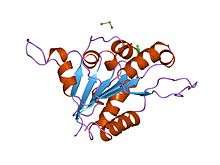Flavoprotein
| Flavoprotein | |||||||||
|---|---|---|---|---|---|---|---|---|---|
 the fmn binding protein athal3 | |||||||||
| Identifiers | |||||||||
| Symbol | Flavoprotein | ||||||||
| Pfam | PF02441 | ||||||||
| InterPro | IPR003382 | ||||||||
| SCOP | 1e20 | ||||||||
| SUPERFAMILY | 1e20 | ||||||||
| |||||||||
Flavoproteins are proteins that contain a nucleic acid derivative of riboflavin: the flavin adenine dinucleotide (FAD) or flavin mononucleotide (FMN).
Flavoproteins are involved in a wide array of biological processes, including, but by no means limited to, bioluminescence, removal of radicals contributing to oxidative stress, photosynthesis, DNA repair, and apoptosis. The spectroscopic properties of the flavin cofactor make it a natural reporter for changes occurring within the active site; this makes flavoproteins one of the most-studied enzyme families.
Discovery
The first mention of a flavoprotein in the scientific literature dates back to 1879, when the work on the composition of cow’s milk resulted in the isolation of a bright-yellow pigment, that we now know as flavin, but termed lactochrome at the time. By the early 1930s, this same pigment had been isolated from a range of sources, and recognised as a component of the vitamin B complex. Its structure was determined almost simultaneously by two groups in 1934, and given the name riboflavin, derived from the ribityl side chain and yellow colour of the conjugated ring system.[1]
The first evidence for the requirement of flavin as an enzyme cofactor came in 1935. Hugo Theorell and coworkers showed that a bright-yellow-coloured yeast protein, identified previously as essential for cellular respiration, could be separated into apoprotein and a bright-yellow pigment. Neither apoprotein nor pigment alone could catalyse the oxidation of NADH, but mixing of the two restored the enzyme activity. However, replacing the isolated pigment with riboflavin did not restore enzyme activity, despite their being indistinguishable under spectroscopy. This led to the discovery that the protein studied required not riboflavin but flavin mononucleotide to be catalytically active[1][2]
Similar experiments with D-amino acid oxidase[3] led to the identification of flavin adenine dinucleotide (FAD) as a second form of flavin utilised by enzymes.[4]
Examples
The flavoprotein family contains a diverse range of enzymes, including:
- Epidermin biosynthesis protein, EpiD, which has been shown to be a flavoprotein that binds FMN. This enzyme catalyses the removal of two reducing equivalents from the cysteine residue of the C-terminal meso-lanthionine of epidermin to form a --C==C-- double bond.[5]
- The B chain of dipicolinate synthase, an enzyme which catalyses the formation of dipicolinic acid from dihydroxydipicolinic acid.[6]
- Phenylacrylic acid decarboxylase EC 4.1.1.-, and enzyme which confers resistance to cinnamic acid in yeast[7]
See also
References
- 1 2 Massey, V (2000). "The chemical and biological versatility of riboflavin". Biochemical Society Transactions. 28 (4): 283–96. doi:10.1042/0300-5127:0280283. PMID 10961912.
- ↑ Theorell, H. (1935). "Preparation in pure state of the effect group of yellow enzymes". Biochemische Zeitschrift. 275: 344–6.
- ↑ Warburg, O.; Christian, W. (1938). "Isolation of the prosthetic group of the amino acid oxydase". Biochemische Zeitschrift. 298: 150–68.
- ↑ Christie, S. M. H.; Kenner, G. W.; Todd, A. R. (1954). "Nucleotides. Part XXV. A synthesis of flavin?adenine dinucleotide". Journal of the Chemical Society: 46–52. doi:10.1039/JR9540000046.
- ↑ Kupke, T; Stevanović, S; Sahl, H. G.; Götz, F (1992). "Purification and characterization of EpiD, a flavoprotein involved in the biosynthesis of the lantibiotic epidermin". Journal of Bacteriology. 174 (16): 5354–61. PMC 206373
 . PMID 1644762.
. PMID 1644762. - ↑ Daniel, R.A.; Errington, J. (1993). "Cloning, DNA Sequence, Functional Analysis and Transcriptional Regulation of the Genes Encoding Dipicolinic Acid Synthetase Required for Sporulation in Bacillus subtilis". Journal of Molecular Biology. 232 (2): 468–83. doi:10.1006/jmbi.1993.1403. PMID 8345520.
- ↑ Clausen, Monika; Lamb, Christopher J.; Megnet, Roland; Doerner, Peter W. (1994). "PAD1 encodes phenylacrylic acid decarboxylase which confers resistance to cinnamic acid in Saccharomyces cerevisiae". Gene. 142 (1): 107–12. doi:10.1016/0378-1119(94)90363-8. PMID 8181743.
External links
- The menu "science" of the program STRAP provides A comprehensive collection of all flavo-proteins with known 3D-structure. It compares the protein structures to elucidate phylogenetic relationships.
This article incorporates text from the public domain Pfam and InterPro IPR003382